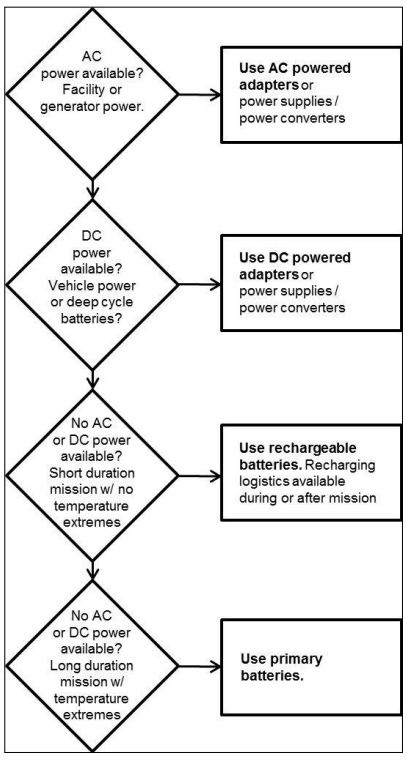Overview
Primary Batteries
The main sources of power for Marine Corps communications equipment are primary batteries; most notably the Lithium-Sulfur Dioxide battery BA-55908/0. Primary batteries are nonrechargeable, one-time use batteries. Increased operational tempo and unexpected production shortfalls have severely reduced the availability of high demand, high-use primary batteries. Units cannot continue to rely on primary batteries as the sole source of power for their communications equipment.
Battery Capacity
No battery is 100% efficient. A 100 Amp-hour (Ah) battery is not likely to produce one amp for 100 hours. Many factors can affect battery capacity, including type of battery, the rate of discharge, depth of discharge, temperature, and age of the battery. These factors vary with battery types as discussed below.
Rechargeable Batteries
Rechargeable batteries are the only option for use with PV systems. While any type of rechargeable battery may be used, leadacid and alkaline batteries are most commonly used in solar systems. Lithium ion batteries are also becoming more frequent in solar applications. While any rechargeable battery can do the job, deep cycle batteries perform best in PV systems.
Deep Cycle Batteries
Every time a battery is drained to any amount and then charged again, it is called a cycle. Depth of discharge refers to how much capacity is withdrawn from the batteries before it is charged again. Solar energy systems often require a battery to discharge small amounts of current over long periods and to recharge under variable conditions. A deep cycle battery is designed for this sort of application. The care and use of a deep cycle battery is the same regardless of its chemical makeup.
NOTE: A car battery is not considered deep cycle. It is designed to be used in short bursts of energy, to start the car, then immediately recharge. You could use a car battery in solar systems but its life cycle would be significantly reduced.
Another factor to consider is the rate and depth of discharge. If a battery is discharged quickly, it will not have as much capacity as if it were drained at a slower rate. For example: A battery is discharged over 24 hours and produces 180 Ah of capacity. That same battery discharged over 8 hours only produces 154 Ah of capacity.
Most deep cycle batteries used with PV systems will be designed for regular discharges of 40 to 80 percent. Battery life will be directly related to how deep the battery is cycled. Drawing deeper into a daily cycle will reduce the overall lifespan of the batteries.
For example; a battery that regularly cycles at 50% until it is charged again will last about twice as long as batteries that cycle to 80% discharge before they are charged.
Rechargeable batteries are labeled with information about the rate and depth of discharge and the battery’s expected total life span. This information is used to determine the amount of capacity the battery bank needs, the size loads to employ, and length of time a battery bank will last.
Effect of Temperature on Batteries
Batteries are very sensitive to temperature.
- In hotter temperatures (100° or more)a battery can be expected to have half its normal life—but, its capacity will increase
- In colder temperatures (32° or less) a battery may only achieve 60%-80% capacity—but its total life will increase
NOTE: It is best to keep batteries in a moderate climate (75°-80°) to operate at expected values. As a rule, once the maximum capacity of the battery bank is less than 20% of its rated capacity—replace it
Tips to Increase Battery Life
- Do not drain lead acid batteries more than 50%
- Lithium ion batteries may be cycled as deep as 100% rated capacity, always refer to manufacture recommendations.
- Discharge the battery banks gradually
- Avoid high loads drawing too much power over short periods – this is not true for high energy lithium batteries; e.g. GREENS1 batteries
- Operate and store batteries in a moderate temperature
Charge Controllers
Charge controllers regulate the voltage and current coming from a generator with solar panels into the battery. They adjust for variable solar panel/array output in response to the variable solar radiation received by the panel/array.
Inverters
Inverters convert the DC output from a battery bank or PV system into alternating current (AC).
Battery Management
Primary battery conservation is intended to ensure long-term availability of primary batteries for those units and missions that have no other option to power their equipment. This entails shifting from primary batteries as the first choice for powering equipment to being the last choice.
Concept of Operations
Leverage the use of power sources available for units and missions instead of primary batteries. Use the following guidelines:
- Reserve the use of primary batteries where they are the only practical option
- If AC power is available, use AC energized power adapters, power supplies, or AC powered power sources/converters to power the equipment
- If DC power is available, use DC energized power sources/converters to power the equipment
- If neither AC nor DC power is available, and the mission can be accomplished using secondary batteries (i.e., rechargeable batteries), then use rechargeable batteries
- Conduct recharging operations during or after use – depending on mission duration
- Recommended use of rechargeable batteries is four to one – four batteries for each piece of battery powered equipment
- one in the equipment
- one for back up
- one in transit to the equipment
- and one on the charger
– some units have successfully used a three to one ratio
Reduce reliance on primary batteries as the sole source of power by establishing practices and procedures to conserve primary batteries for the use in equipment applications to those missions where they are the only practical option. Figure 1 arrays options.

